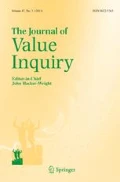Notes
I am grateful to an anonymous reviewer for this journal for stressing the need to address the connections between the conceptions of sainthood of Wolf and Adams and their deeper, moral theoretical analyses.
Susan Wolf, “Moral Saints,” in Vice and Virtue in Everyday Life (New York: Harcourt, Brace and Jovanovich, 1989), 2nd ed., Christina and Fred Sommers, eds., 442–62, p. 446.
Ibid., p. 460.
Ibid., p. 445.
Ibid., p. 451–2.
Consider the parallel with martyrdom. On my interpretation, the religious martyr cannot desire martyrdom at the risk of a self-seeking, self-aggrandizement that would vitiate the martyrdom. The martyr’s calling is to preach her religious truth, the martyrdom resulting; though perhaps understood as a possibility, it is not a goal. The secular martyr is typically an individual who advocates for justice or radical political change. Although Martin Luther King and Gandhi had strong religious convictions, their martyrdom can be understood as primarily secular.
Ibid., p. 446.
Ibid., p.457
Wolf, “Moral Saints,” pp. 450–52, pp. 460–61.
Ibid., p. 449.
Ibid., pp. 451–52.
Robert M. Adams, “Saints,” Vice and Virtue in Everyday Life, 463–75, p. 469.
Ibid., p. 471.
Ibid.
Adams, “Saints,” p. 468.
J.O. Urmson, “Saints and Heroes,” in Essays in Moral Philosophy, ed. I.A. Melden (Seattle: University of Washington, 1957), p. 202.
M. Scott Peck, The Road Less Travelled (New York: Simon and Schuster, 1978), p. 120.
Ibid., p. 126. Iris Murdoch explains the connection between attention and love or care this way: “Love… is an exercise of … really looking. The difficulty is to keep the attention fixed upon the real situation and to prevent it from returning surreptitiously to the self…” The Sovereignty of Good (New York: Schocken Books, 1971), p. 91.
This is a view implicit in the tenor of Wolf’s perspective and one that is perhaps erroneously attributed by Blum to Urmson, “Moral Exemplars: Reflections on Schindler, the Trocmes, and Others,” Midwest Studies in Philosophy, Vol. 13, 1988, 196–221, 206.
Adams, “Saints,” p.469.
James Wallace, Virtues and Vices (Ithaca, N.Y.: Cornell University Press, 1978), p. 132.
Martin Luther, Luther’s Work, vol. 21, trans. And ed. Jaroslav Pelikan (St. Louis, Concordia, 1956), p. 375.
Anthony Skillen, “Can a Good Man Know Himself?” Philosophical Investigations, vol. 18, April 1995, 151–55.
Urmson, “Saints and Heroes,” p. 206.
Skillen, “Can a Good Man Know Himself?” p. 154.
Stephen Hare, “The Paradox of Moral Humility,” American Philosophical Quarterly, vol. 33, April 1996, 235–241, p. 237.
Such loss of self-awareness can occur when we are doing things that have nothing to do with virtue, such as playing a sport, reading a terrific story, or doing riveting research. But the absence of self-awareness with regard to the virtues is nonetheless significant, in that here self-forgetfulness is a result of the impact of the virtue.
Adams, “Saints,” p. 471.
Ibid.
Lawrence Blum suggests something like a secular saint in “Moral Exemplars: Reflections on Schindler, the Trocmes, and Others.”
Christianity, and Catholicism in particular, celebrates sainthood most distinctively. Judaism, for example, is replete with teachers (rabbis), prophets, champions and politico-religious leaders, but lacks a saintly tradition.
Richard Sorabji, “Stoic First Movements in Christianity,” in Stoicism: Traditions and Transformations,” eds. Steven Strange and Jack Zupko (Cambridge: Cambridge University, 2004), 95–107, p. 102.
In the Critique of Judgment, Kant distinguishes the mathematically sublime (inspired by large or numerous objects) from dynamic sublimity (generated by powerful natural forces).
Author information
Authors and Affiliations
Corresponding author
Rights and permissions
About this article
Cite this article
Kupfer, J. Sainthood and the Good Life. J Value Inquiry 51, 263–278 (2017). https://doi.org/10.1007/s10790-016-9568-3
Published:
Issue Date:
DOI: https://doi.org/10.1007/s10790-016-9568-3

